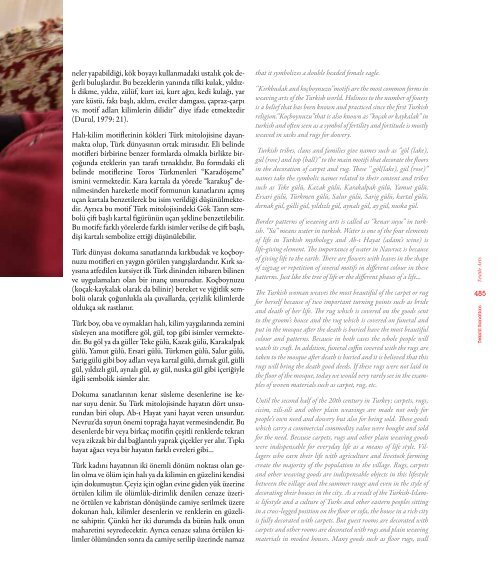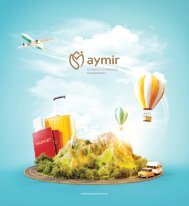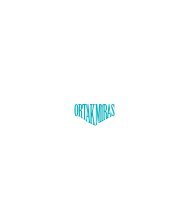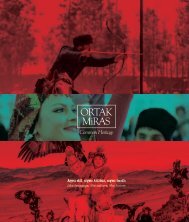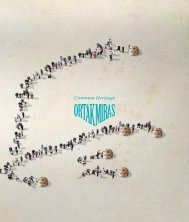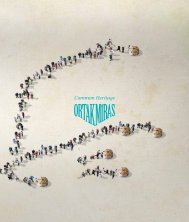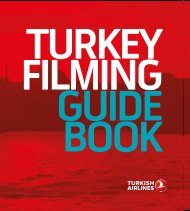Create successful ePaper yourself
Turn your PDF publications into a flip-book with our unique Google optimized e-Paper software.
neler yapabildiği, kök boyayı kullanmadaki ustalık çok değerli<br />
buluşlardır. Bu bezeklerin yanında tilki kulak, yıldızlı<br />
dikme, yıldız, zülüf, kurt izi, kurt ağzı, kedi kulağı, yar<br />
yare küstü, fakı başlı, aklım, evciler damgası, çapraz-çarpı<br />
vs. motif adları kilimlerin dilidir” diye ifade etmektedir<br />
(Durul, 1979: 21).<br />
Halı-kilim motiflerinin kökleri Türk mitolojisine dayanmakta<br />
olup, Türk dünyasının <strong>ortak</strong> <strong>miras</strong>ıdır. Eli belinde<br />
motifleri birbirine benzer formlarda olmakla birlikte birçoğunda<br />
eteklerin yan tarafı tırnaklıdır. Bu formdaki eli<br />
belinde motiflerine Toros Türkmenleri “Karadöşeme”<br />
ismini vermektedir. Kara kartala da yörede “karakuş” denilmesinden<br />
hareketle motif formunun kanatlarını açmış<br />
uçan kartala benzetilerek bu isim verildiği düşünülmektedir.<br />
Ayrıca bu motif Türk mitolojisindeki Gök Tanrı sembolü<br />
çift başlı kartal figürünün uçan şekline benzetilebilir.<br />
Bu motife farklı yörelerde farklı isimler verilse de çift başlı,<br />
dişi kartalı sembolize ettiği düşünülebilir.<br />
Türk dünyası dokuma sanatlarında kırkbudak ve koçboynuzu<br />
motifleri en yaygın görülen yangışlardandır. Kırk sayısına<br />
atfedilen kutsiyet ilk Türk dininden itibaren bilinen<br />
ve uygulamaları olan bir inanç unsurudur. Koçboynuzu<br />
(koçak-kaykalak olarak da bilinir) bereket ve yiğitlik sembolü<br />
olarak çoğunlukla ala çuvallarda, çeyizlik kilimlerde<br />
oldukça sık rastlanır.<br />
Türk boy, oba ve oymakları halı, kilim yaygılarında zemini<br />
süsleyen ana motiflere göl, gül, top gibi isimler vermektedir.<br />
Bu göl ya da güller Teke gülü, Kazak gülü, Karakalpak<br />
gülü, Yamut gülü, Ersari gülü, Türkmen gülü, Salur gülü,<br />
Sarig gülü gibi boy adları veya kartal gülü, dırnak gül, gülli<br />
gül, yıldızlı gül, aynalı gül, ay gül, nuska gül gibi içeriğiyle<br />
ilgili sembolik isimler alır.<br />
Dokuma sanatlarının kenar süsleme desenlerine ise kenar<br />
suyu denir. Su Türk mitolojisinde hayatın dört unsurundan<br />
biri olup, Ab-ı Hayat yani hayat veren unsurdur.<br />
Nevruz’da suyun önemi toprağa hayat vermesindendir. Bu<br />
desenlerde bir veya birkaç motifin çeşitli renklerde tekrarı<br />
veya zikzak bir dal bağlantılı yaprak çiçekler yer alır. Tıpkı<br />
hayat ağacı veya bir hayatın farklı evreleri gibi…<br />
Türk kadını hayatının iki önemli dönüm noktası olan gelin<br />
olma ve ölüm için halı ya da kilimin en güzelini kendisi<br />
için dokumuştur. Çeyiz için oğlan evine giden yük üzerine<br />
örtülen kilim ile ölümlük-dirimlik denilen cenaze üzerine<br />
örtülen ve kabristan dönüşünde camiye serilmek üzere<br />
dokunan halı, kilimler desenlerin ve renklerin en güzeline<br />
sahiptir. Çünkü her iki durumda da bütün halk onun<br />
maharetini seyredecektir. Ayrıca cenaze salına örtülen kilimler<br />
ölümünden sonra da camiye serilip üzerinde namaz<br />
that it symbolizes a double headed female eagle.<br />
‘’Kırkbudak and koçboynuzu’’motifs are the most common forms in<br />
weaving arts of the Turkish world. Holiness to the number of fourty<br />
is a belief that has been known and practiced since the first Turkish<br />
religion.’’Koçboynuzu’’that is also known as ‘’koçak or kaykalak’’ in<br />
turkish and often seen as a symbol of fertility and fortitude is mostly<br />
weaved in sacks and rugs for dowery.<br />
Turkish tribes, clans and families give names such as ‘’göl (lake),<br />
gül (rose) and top (ball)’’ to the main motifs that decorate the floors<br />
in the decoration of carpet and rug. These ‘’ göl(lake), gül (rose)’’<br />
names take the symbolic names related to their content and tribes<br />
such as Teke gülü, Kazak gülü, Karakalpak gülü, Yamut gülü,<br />
Ersari gülü, Türkmen gülü, Salur gülü, Sarig gülü, kartal gülü,<br />
dırnak gül, gülli gül, yıldızlı gül, aynalı gül, ay gül, nuska gül.<br />
Border patterns of weaving arts is called as ‘’kenar suyu’’ in turkish.<br />
‘’Su’’ means water in turkish. Water is one of the four elements<br />
of life in Turkish mythology and Ab-ı Hayat (adam’s wine) is<br />
life-giving element. The importance of water in Nawruz is because<br />
of giving life to the earth. There are flowers with leaves in the shape<br />
of zigzag or repetition of several motifs in different colour in these<br />
patterns. Just like the tree of life or the different phases of a life...<br />
The Turkish woman weaves the most beautiful of the carpet or rug<br />
for herself because of two important turning points such as bride<br />
and death of her life. The rug which is covered on the goods sent<br />
to the groom’s house and the rug which is covered on funeral and<br />
put in the mosque after the death is buried have the most beautiful<br />
colour and patterns. Because in both cases the whole people will<br />
watch its craft. In addition, funeral coffin covered with the rugs are<br />
taken to the mosque after death is buried and it is believed that this<br />
rugs will bring the death good deeds. If these rugs were not laid in<br />
the floor of the mosque, today we would very rarely see in the examples<br />
of woven materials such as carpet, rug, etc.<br />
Until the second half of the 20th century in Turkey; carpets, rugs,<br />
cicim, zili-sili and other plain weavings are made not only for<br />
people’s own need and dowery but also for being sold. These goods<br />
which carry a commercial commodity value were bought and sold<br />
for the need. Because carpets, rugs and other plain weaving goods<br />
were indispensable for everyday life as a means of life style. Villagers<br />
who earn their life with agriculture and livestock farming<br />
create the majority of the population to the village. Rugs, carpets<br />
and other weaving goods are indispensable objects in this lifestyle<br />
between the village and the summer range and even in the style of<br />
decorating their houses in the city. As a result of the Turkish-Islamic<br />
lifestyle and a culture of Turks and other eastern peoples sitting<br />
in a cross-legged position on the floor or sofa, the house in a rich city<br />
is fully decorated with carpets. But guest rooms are decorated with<br />
carpets and other rooms are decorated with rugs and plain weaving<br />
materials in modest houses. Many goods such as floor rugs, wall<br />
Textile Arts<br />
485<br />
Tekstil Sanatları


